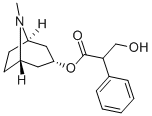LN-684383
Acetylcholine , 98% HPLC , 51-84-3
Update time: 2023-04-23
PRODUCT Properties
| Boiling point: | 265.84°C (rough estimate) |
| Density | 1.0528 (rough estimate) |
| refractive index | 1.4500 (estimate) |
| solubility | Water (easy), ethanol (easy), ether (not easy) |
| CAS DataBase Reference | 51-84-3 |
| EPA Substance Registry System | Acetylcholine (51-84-3) |
Description and Uses
Acetylcholine is stored in vesicles in the presynaptic neuron. These fuse with presynaptic membrane upon stimulation by a nerve signal, thus, generating a pulse of neurotransmitter, which diffuses across the membrane. Acetylcholine may either bind reversibly to one of two different types of acetylcholine receptors on the postsynaptic membrane or be destroyed by the acetylcholine-hydrolyzing enzyme, acetylcholinesterase.
neurotransmitter (ester of choline and acetic acid)
Safety
| RIDADR | 1760 |
| HazardClass | 8 |
| PackingGroup | II |
| Toxicity | The choline ester of acetic acid. ACh is released in vertebrates as the neurotransmitter for cholinergic neurons in the CNS, as well as at several peripheral locations: somatic neurons innervating skeletal muscle (neuromuscular junctions); preganglionic neurons in both divisions of the autonomic nervous system; parasympathetic postganglionic neurons; and a few sympathetic postganglionic neurons. ACh is synthesized from choline and acetyl CoA by the mitochondrial enzyme choline acetyltransferase. Cholinergic receptors (cholinoceptors), that mediate the effects of ACh, are generally classified as nicotinic or muscarinic, based on their binding preferences for nicotine and muscarine, respectively. ACh is hydrolyzed to choline and acetate by acetylcholinesterase, that is an important target for a variety of toxic and therapeutic anticholinesterases, such as the nerve agents, carbamate, and organophosphorus insecticides. |





